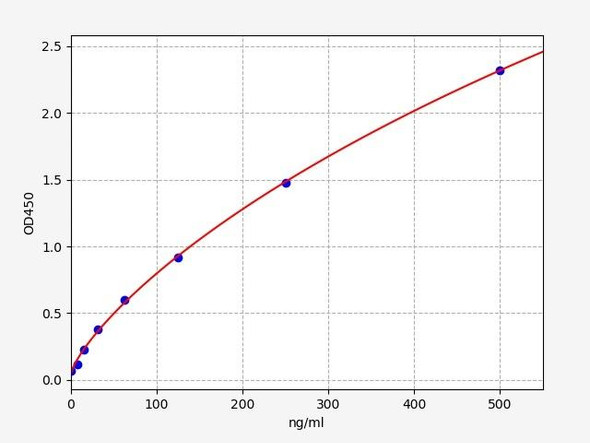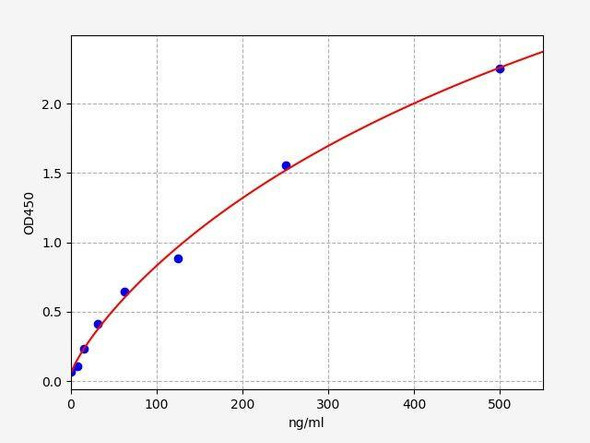Description
| Product Name: | CPD (cyclobutane pyrimidine dimers)ELISA Kit |
| SKU: | AEFI01521 |
| Size: | 96T |
| Reactivity: | Universal |
| Range: | 0.156-10ng/ml |
| Sensitivity: | 0.094ng/ml |
| Detection Method: | Competitive ELISA, Coated with Antigen |
| Detection Wavelength: | OD450 |
| Reaction Duration: | 2 hours |
| Synonyms: | CPD ELISA Kit, cyclobutane pyrimidine dimers ELISA Kit |
| Kit Components: |
| ||||||||||||||||||||||||||||||||||||||||||||||||||||
Other Materials Required (Not provided)
- Microplate reader (wavelength: 450nm)
- 37°C incubator (CO2 incubator for cell culture is not recommenced.)
- Automated plate washer or multi-channel pipette/5ml pipettor (for manual washing purpose)
- Precision single (0.5-10μL, 5-50μL, 20-200μL, 200-1000μL) and multi-channel pipette with disposable tips(Calibration is required before use.)
- Sterile tubes and Eppendorf tubes with disposable tips
- Absorbent paper and loading slot
- Deionized or distilled water
This kit is based on Competitive-ELISA detection method and takes 2h assay time. The microplate provided in this kit has been precoated with CPD. CPD in the sample or standard competes with a fixed amount of biotin-labeled CPD for sites on a pre-coated antibody specific to CPD. Free components are washed off. After adding HRP-Streptavidin Conjugate (SABC), biotin specifically binds with streptavidin to form immune complexes. Wash off unbound conjugate. Add TMB substrate solution. Then, TMB was catalyzed by HRP to produce a blue color product that turned yellow after adding a stop solution. Read the O.D. absorbance at 450nm in a microplate reader. Compare OD450 value of sample with the standard curve through curve fitting software to determine the concentration of CPD in the sample. The concentration of the target substance is inversely proportional to the OD450 value.
| Recovery: | Add a certain amount of CPD into the sample. Calculate the recovery by comparing the measured value with the expected amount of CPD in the sample.
| ||||||||||||||||||||||||||||||||||||||||||
| Linearity: | Dilute the sample with a certain amount of CPD at 1:2, 1:4 and 1:8 to get the recovery range.
| ||||||||||||||||||||||||||||||||||||||||||
| Precision: | Intra-assay Precision: samples with low, medium and high concentration are tested 20 times on the same plate. Inter-assay Precision: samples with low, medium and high concentration are tested 20 times on three different plates.
| ||||||||||||||||||||||||||||||||||||||||||
*Note:The below protocol is a sample protocol. Protocols are specific to each batch/lot. For the correct instructions please follow the protocol included in your kit.
| Step | Protocol |
| 1. | Wash the plate twice before adding the standard and sample. |
| 2. | Add 50ul standard or sample into each well. Immediately add 50ul biotin-labeled antibody working solution into each well(The tip can't be reused after touching the liquid.), gently shake the plate for 1min, seal closely and statically incubate for 45 minutes at 37°C. |
| 3. | Washing: Wash the plate three times and immerse for 1min each time. |
| 4. | Add 100ul HRP-Streptavidin Conjugate (SABC) working solution into each well, seal the plate and statically incubate for 30 minutes at 37°C. |
| 5. | Washing: Wash the plate five times and immerse for 1min each time. |
| 6. | Add 90ul TMB substrate solution, seal the plate and statically incubate for 10-20 minutes at 37°C. (Accurate TMB visualization control is required.) |
| 7. | Add 50ul stop solution. Read at 450nm immediately and calculate. |
When carrying out an ELISA assay it is important to prepare your samples in order to achieve the best possible results. Below we have a list of procedures for the preparation of samples for different sample types.
| Sample Type | Protocol |
| Serum | Place whole blood sample at room temperature for 2 hours or put it at 2-8°C overnight and centrifugation for 20 minutes at approximately 1000×g, Collect the supernatant and carry out the assay immediately. Blood collection tubes should be disposable, non-pyrogenic, and non-endotoxin.. |
| Plasma | The concentration of free CPD in plasma is very low relative to the level of DNA-incorporated CPD. Glomerular filtration results in excretion of CPD into the urine, while the DNA incorporated CPD remains in the blood. The differing fates of free versus DNA-incorporated CPD should be considered in experimental design. If you choose to measure DNA-incorporated CPD in plasma, it may be preferable to purify DNA using a commercially available kit and treat the DNA with a combination of nuclease and alkaline phosphatase to liberate the individual bases. Due to the complexities of measuring CPD in plasma, urine is often a more appropriate matrix.. |
| Urine | Collect urine according to standard procedure into a sterile container. To clarify, centrifuge 2,000 x g for 15 minutes, or filter using a 0.45μm filter to remove precipitate. Assay immediately or store at ≤-20°C in aliquots for later use. Avoid repeated freeze-thaw cycles.. |
| Saliva | Collect saliva according to standard procedure in a centrifuge tube. To clarify, centrifuge at 2,000 x g for 15 minutes. Carefully remove supernatant and assay immediately or store at ≤-20°C in aliquots for later use. Avoid repeated freeze-thaw cycles.. |
| Cell Culture Supernatant | Collect the supernatant: Centrifuge at 2500 rpm at 2-8℃ for 5 minutes, then collect clarified cell culture supernatant to detect immediately. Or you can aliquot the supernatant and store it at -80°C for future’s assay.. |
| DNA extraction of other samples | Cultured Suspension Cells - Grow 1-5 x 106 cells in suspension using complete medium in a suitable tissue culture plate or flask. Count the cells. Harvest cells by centrifugation and remove growth medium. Wash one time with 1X PBS. Suspend cell pellets at 1x106 cells/ml in ice-cold 1X PBS. For example, add 5 mL 1X PBS to 5 x 106 cells. Aliquot 1 ml into 1.5 ml microcentrifuge tubes. Centrifuge at 10,000 x g for 10 seconds at 2-8 °C. Proceed to DNA Extraction. (Cell pellets can be flash frozen in liquid nitrogen and stored at ≤-70°C for later use.) Cultured Adherent Cells - Grow 1-5 x 106 adherent cells in complete medium in a suitable tissue culture dish or flask until 75% confluent. Remove the growth medium and harvest cells by trypsinization or a method of choice. Count the cells. Wash one time with 1X PBS. Suspend the cell pellets at 1x10 6 cells/ml in ice-cold 1X PBS. For example, add 5 ml 1X PBS to 5 x 106 cells. Aliquot 1 ml into 1.5 ml microcentrifuge tubes. Centrifuge at 10,000xg for 10 seconds at 2-8°C. Discard supernatant. Proceed to DNA Extraction. (Cell pellets can also be flash frozen in liquid nitrogen and stored at ≤ -70°C for later use). Tissue Samples - The tissue specimen should be cut into a 2 mm cube and weigh approximately 8-12mg in mass. Proceed to DNA Extraction. DNA Extraction - Extract DNA from the above cultured cells or tissue samples by a desired method or commercial extraction kit. (Generally the minimal amount of extracted DNA required for each sample is 20-. |
| ) Quantitate DNA spectrophotometrically (OD260 = 50μg/ml). The suggested final DNA concentration is | 200μg/ml to 1000μg/ml. Add Mg2+ and Ca2+ to DNA solution (the final concentration of Mg2+ is 2.5-10mM , the final concentration of Ca2+ is 0.5-1mM). Then Add 2μL DNase I (5 Units/μL) per 50μg DNA and incubate for 1 hour at 37°C. DNA is cut to form oligonucleotides and mononucleotides. Then, add 2μL Alkaline Phosphatase (1 Unit/μL) per 50μg DNA and incubate 1 hour at 37°C. Alkaline Phosphatas removes the 5 'end phosphate group of deoxynucleotide to prevent the connection of the 5' end and the 3 'end, so that the deoxynucleotide is in a linearized state, which is conducive to detection. Assay immediately or aliquot and store at ≤ -20°C. |
| Sample Type: | Serum, Plasma, Cell culture supernatant, Cell or tissue lysate, Urine, Other liquid samples |
| Storage: | 2-8°C(Sealed), Don't cryopreserve. |
| Specificity: | Specifically binds with CPD , no obvious cross reaction with other analogues. |






